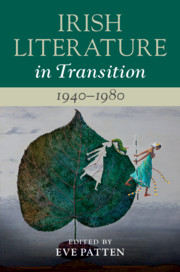Book contents
- Irish Literature in Transition, 1940–1980
- Irish Literature in Transition
- Irish Literature in Transition, 1940–1980
- Copyright page
- Contents
- Contributors
- Series Preface
- General Acknowledgements
- Introduction
- Part I After the War: Ideologies in Transition
- Part II Genres in Transition
- Part III Sex, Politics and Literary Protest
- Part IV Identities and Connections
- Part V Retrospective Frameworks: Criticism in Transition
- Chapter 17 Literary Biography in Transition
- Chapter 18 Publishing, Penguin and Irish Writing
- Chapter 19 Curriculum to Canon: Irish Writing and Education
- Chapter 20 Critics, Criticism and the Formation of an Irish Literary Canon
- Index
Chapter 18 - Publishing, Penguin and Irish Writing
from Part V - Retrospective Frameworks: Criticism in Transition
Published online by Cambridge University Press: 28 February 2020
- Irish Literature in Transition, 1940–1980
- Irish Literature in Transition
- Irish Literature in Transition, 1940–1980
- Copyright page
- Contents
- Contributors
- Series Preface
- General Acknowledgements
- Introduction
- Part I After the War: Ideologies in Transition
- Part II Genres in Transition
- Part III Sex, Politics and Literary Protest
- Part IV Identities and Connections
- Part V Retrospective Frameworks: Criticism in Transition
- Chapter 17 Literary Biography in Transition
- Chapter 18 Publishing, Penguin and Irish Writing
- Chapter 19 Curriculum to Canon: Irish Writing and Education
- Chapter 20 Critics, Criticism and the Formation of an Irish Literary Canon
- Index
Summary
This chapter surveys how Irish titles singled out for reprinting by the British firm Penguin were presented in terms of the materiality of the book as an object, and particularly in the paratextual zones of their editions. It discusses how writers such as Liam O’Flaherty, Joyce Cary, Elizabeth Bowen and Seán O’Faoláin were reprinted, branded and circulated by the British firm Penguin, drawing on Gérard Genette’s concept of the paratext as denoting the threshold area or gateway to the text, which comprises elements like cover art, blurbs, laudatory quotations reprinted on covers or endpapers, and editorial introductions. It then offers a case study of one major Irish writer, the novelist Kate O’Brien, and explores how her novels were packaged and marketed within the Penguin and wider reprints milieu. The conclusion juxtaposes the publication of Irish writing by a London-based mass-market concern like Penguin with the activities of the Dolmen Press in Ireland. This native Dublin-based publishing house was modest in comparison to major British commercial presses, but would nonetheless evolve into an important force in the construction of an Irish literary culture in this period in its conscious definition of itself in opposition to international mass-market entities like Penguin.
- Type
- Chapter
- Information
- Irish Literature in Transition, 1940–1980 , pp. 329 - 343Publisher: Cambridge University PressPrint publication year: 2020
- 1
- Cited by



